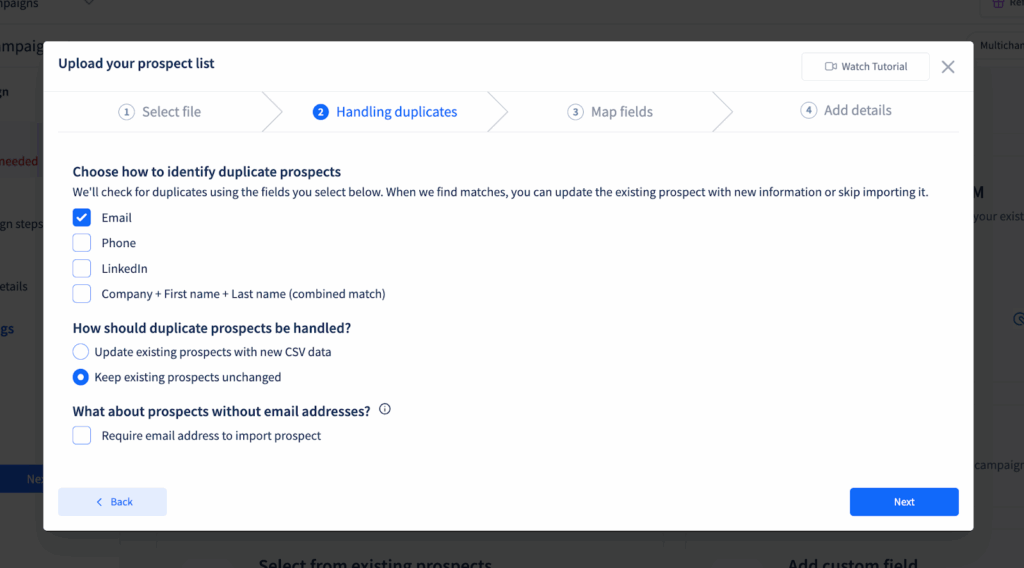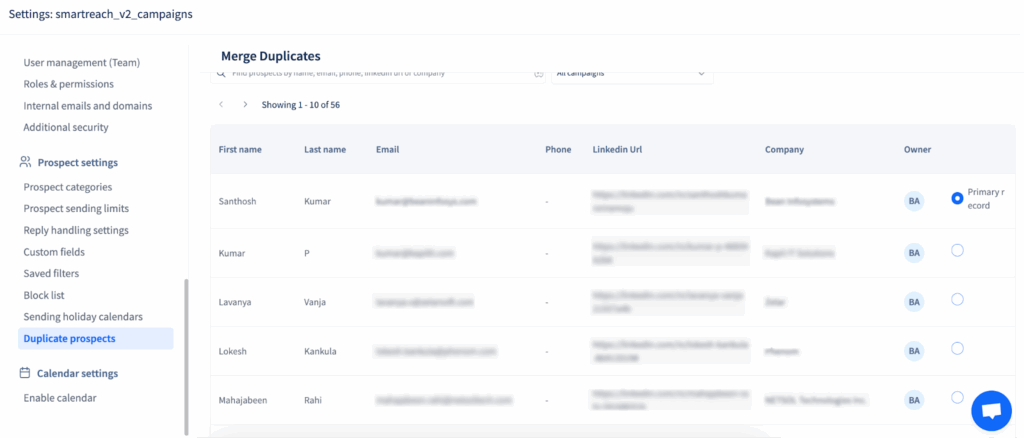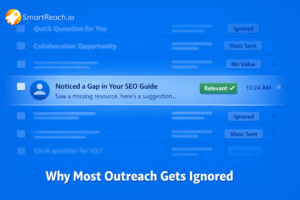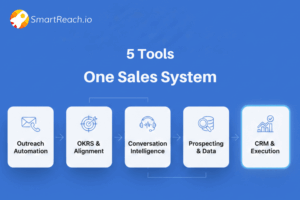Prevent Duplicate Emails Across Campaigns | SmartReach
Sending the same email to a prospect more than once can do more harm than good.
When a person receives duplicate emails, it feels unprofessional and makes your outreach look disorganized.
This problem often shows up when multiple email campaigns are running at the same time, when different team members are reaching out without proper coordination, or when imported prospect lists contain overlapping contacts.
Without a system in place to catch these duplicates, the risk of sending repeated emails only increases as your outreach grows.
In the blog, we are going to discuss how you can avoid sending duplicate emails to prospects.
How does duplicate outreach hurt your campaigns?
When prospects receive multiple emails from your company, they don’t just delete them and move on.
They form lasting impressions about your business that directly impact your ability to close deals.
- Damages your brand reputation → Prospects see uncoordinated outreach as a sign your team lacks organization and professionalism.
- Reduces email deliverability → Repeated sends to the same contact raise red flags with Gmail, Outlook, and other providers, pushing future emails toward spam.
- Kills response rates → Once recipients associate your company with duplicate messages, even your best emails get ignored.
- Wastes resources → Every duplicate email drains time, effort, and money that could go toward reaching new prospects.
- Creates compliance risks → Sending multiple emails to the same person increases the chances of spam complaints and regulatory issues under CAN-SPAM or GDPR.
- Damages long-term relationships → Prospects who feel spammed are less likely to engage with your company again, even after you fix the problem.
6 Common ways of email getting duplicated
Duplicate emails don’t just appear out of nowhere; they’re usually the result of small process gaps that add up as your outreach grows.
Here are the most common scenarios:
1. Overlapping prospect imports
Different team members upload separate email lists without cross-checking.
For example, A trade show list and a LinkedIn list might share dozens of the same contacts, leading to multiple campaigns hitting the same people.
2. Similar campaigns targeting the same audience
Two campaigns may sound different, like “HR directors at mid-size companies” vs. “decision-makers in growing businesses”, but often reach the same prospects.
3. No visibility across active campaigns
Without shared access, one rep doesn’t know another is already emailing the same leads.
Marketing teams sending bulk promos at the same time make this even worse.
4. CRM sync issues creating duplicates
When data isn’t cleaned, the same person ends up with multiple records (work email, personal email, slight name variations), making them appear as different contacts.
5. Manual list building without checks
Sales reps often focus on adding good leads quickly rather than confirming whether those leads are already in the system.
6. Reactivation campaigns colliding with active sequences
Contacts labeled “inactive” may already be part of another nurture or follow-up sequence, causing conflicting messaging.
Why is contact deduplication across campaigns critical?
Keeps your brand professional
When each prospect receives a single, consistent message, your company looks organized and trustworthy.
Protects deliverability and sender reputation
Removing duplicates means fewer spam complaints, better inbox placement, and higher open rates.
Improves team efficiency
Your reps can focus on reaching new leads instead of accidentally chasing the same ones.
Ensures accurate reporting
Clean data gives you a true picture of campaign performance without inflated send counts or misleading metrics.
Strengthens prospect relationships
Coordinated outreach feels more personal and respectful, making prospects more likely to respond positively.
How does SmartReach.io solve the duplicate prospect problem?
SmartReach.io is an AI-enhanced sales engagement platform that helps teams automate outreach, personalize at scale, and close more deals with less effort.
SmartReach.io makes it easy to keep your contact lists clean, campaigns coordinated, and reputations intact.
Here’s how it handles duplicates, without you having to sweat the details:
1. Smarter CSV uploads that prevent duplicates before they happen
When uploading prospects in SmartReach.io, duplicates are filtered out during the import process itself.
In the second step of a CSV upload, you get full control over how duplicates are identified and handled:
- Flexible matching criteria: You can flag duplicates by email, phone number, LinkedIn profile, or even by combining company name with first and last name. This ensures that even if someone uses different email addresses, you can still detect them as the same prospect.
- Control how records are handled: Once duplicates are identified, you decide whether to update existing records with fresh data from the CSV or leave them unchanged to preserve the information you already have.
- Keep your list clean from incomplete data: You can set a requirement for email addresses to make sure only valid, usable contacts are imported, preventing clutter from partial records.

By managing duplicates at the upload stage, SmartReach.io ensures your campaigns only target unique prospects, eliminating the risk of sending multiple emails to the same person.
2. Merge duplicates, or just block them from your dashboard
SmartReach logs all potential duplicates under ‘Duplicate Prospects’, within ‘Settings’.
From there, you can:
- Select a primary record you want to keep.
- Preview details, then merge duplicate entries into one unified profile.
That means no loose, overlapping contacts cluttering your lists, and nothing sneaks through multi-campaign sends.

3. Apply duplicate logic even when adding prospects manually
If you’re adding one-off prospects manually, SmartReach still offers duplicate handling.

On the “Add prospect” form, you’ll see options like:
- Ignore if active in another campaign
- Ignore if assigned anywhere
You can also opt to update fields for duplicates so any fresh info merges right in.
With SmartReach.io, duplicate prevention isn’t an afterthought; it’s built into every step, keeping your outreach clean, consistent, and professional.
What to do when duplicates have already been sent?
Even with good processes, mistakes happen. If prospects have already received duplicate emails, quick and thoughtful action can limit the damage and even turn the situation into an opportunity to build trust.
1. Identify affected prospects quickly
Run reports from all active campaigns to find out who received multiple emails and when. Focus on recent sends (past 7–14 days), as those are the ones prospects are most likely to notice.
2. Acknowledge the mistake with a short, honest email
Don’t ignore the issue.
A simple note works best:
| “Hi [Name], you may have received a couple of emails from our team recently. We had a coordination issue on our end, apologies for the confusion. I wanted to personally reach out about [specific value proposition].” |
This approach feels genuine and helps maintain credibility.
3. Pause outreach to these contacts
Remove duplicates from all active campaigns for at least two weeks. Giving prospects a break shows respect for their inbox and reassures them that the issue is resolved.
4. Re-engage with higher-value content
When you resume outreach, offer something more compelling than your usual pitch, exclusive insights, an invite to a webinar, or a free consultation.
This helps you rebuild goodwill.
5. Fix the root cause
Document how the duplicates happened and update your processes. Better CRM sync, clearer ownership of prospect lists, or improved team visibility can prevent repeats.
Tools like SmartReach.io integrate deeply with CRMs such as Salesforce and HubSpot to keep contact data clean and synchronized, reducing the risk of duplicate records.
10 Best practices to avoid sending duplicate emails to prospects
Preventing duplicates is easier than fixing them later.
A few structured steps and the right habits can ensure your prospects never receive the same email twice.
1. Maintain a single source of truth for contacts
Keep all your prospect data in one CRM or outreach platform.
When everyone works from the same database, it’s easier to see who’s already being contacted.
2. Clean and deduplicate lists before uploading
Run every new list through a deduplication check.
This removes overlapping records before they reach your outreach tool.
3. Use suppression lists
Maintain a global suppression list of prospects who should not receive further outreach. This ensures no new campaign accidentally contacts them again.
4. Share visibility across your team
Give your SDRs, AEs, and marketing team access to see active campaigns and sequences. Transparency helps avoid stepping on each other’s toes.
5. Define clear ownership of prospects
Assign contacts to specific team members or territories. When everyone knows who’s responsible for which leads, duplicates become less likely.
6. Integrate your CRM and outreach platform
Syncing data between systems ensures changes are updated in real time and prevents duplicate contact records caused by manual imports.
7. Establish a pre-campaign checklist
Before launching a new sequence, verify that none of the prospects are already in other campaigns. Make this a standard step in your outreach process.
8. Limit manual list building
Manual prospecting is prone to errors. Use verified data sources or enrichment tools that can automatically check for duplicates.
9. Document your process
Write down clear rules for how contacts are added, assigned, and managed. A consistent process reduces confusion as your team scales.
10. Review campaign reports regularly
Monitor performance data to spot unexpected overlaps early. If the same prospect appears in multiple campaign reports, take corrective action immediately.
Duplicate emails might seem like a small mistake, but they can damage your reputation, hurt deliverability, and waste valuable sales effort.
With the right processes, clean data, clear ownership, and proper team visibility, you can keep your outreach organized and professional. And with a platform like
SmartReach.io handles duplicate detection and prospect management automatically, so you never have to worry about hitting the same prospect twice.
Try SmartReach.io FREE for 14 days
Frequently asked questions about duplicate email prevention
How do you know if you’re sending duplicate emails?
Check your campaign reports for contacts appearing in multiple active sequences. Most sales engagement platforms show overlap statistics, but you can also export contact lists and use Excel to identify duplicates across campaigns.
What tools prevent duplicate emails automatically?
Sales engagement platforms like SmartReach provide automated deduplication across all campaigns and team members. CRM systems help but typically only prevent duplicates within individual campaigns, not across multiple outreach efforts.
How long should you wait before emailing prospects again?
Wait at least 30 days between campaigns targeting the same prospect. If they’ve responded to any outreach, wait 90 days minimum before starting new sequences. Active prospects should be moved to personal outreach rather than automated campaigns.
What happens if duplicates slip through anyway?
If a prospect receives multiple emails by mistake, acknowledge it quickly with a short, honest note and pause outreach for at least two weeks. This prevents further irritation and shows you’re taking steps to fix the issue.
Can CRM deduplication solve everything?
Not completely. CRMs typically handle duplicate records within their own database, but they don’t always prevent multiple sequences from hitting the same contact when you run separate campaigns or when multiple team members are involved.
What’s the difference between suppression lists and deduplication?
A suppression list blocks specific contacts or domains from receiving any emails, regardless of the campaign. Deduplication makes sure each prospect appears only once in your outreach, even across multiple campaigns. Both are useful, but they solve different problems.
How do team collaboration issues lead to duplicates?
When team members can’t see each other’s campaigns or prospect lists, they may target the same people unknowingly. Shared dashboards, user permissions, and cross-campaign visibility features prevent this overlap.
Are duplicates always bad?
Almost always, yes. Sending two identical emails from different reps looks disorganized and hurts your reputation. However, deliberate multi-touch campaigns, when coordinated properly, can work if each message adds new value and comes from the same sender or company voice.
What’s the simplest manual way to check for duplicates?
Export your contact lists from different campaigns, combine them in Excel or Google Sheets, and use conditional formatting or formulas (like COUNTIF) to flag repeat email addresses, phone numbers, or LinkedIn URLs.




